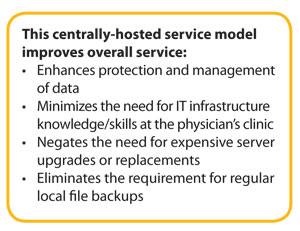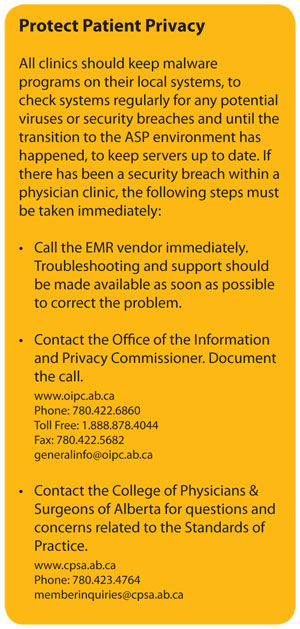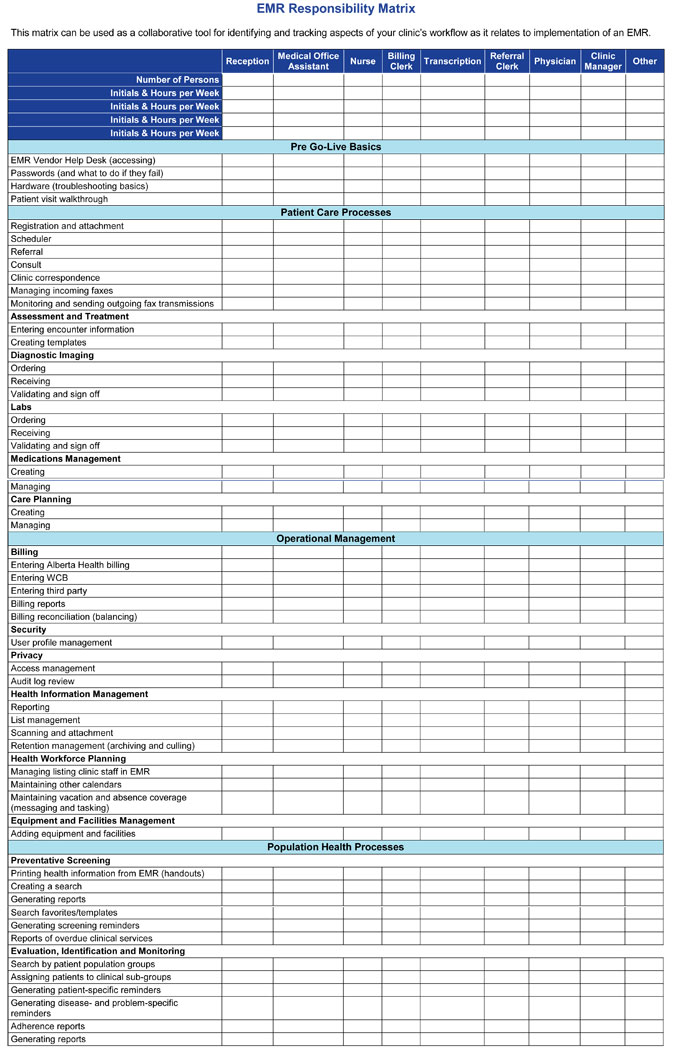The first step in your EMR journey involves selecting an EMR. This begins with understanding your business requirements, assessing the state of your current patient records, knowing your medical-legal obligations, selecting your clinic team and finally, reviewing the EMR products available.
In this section you will find planning resources to assist you in preparing your path to implementation and comparing your clinic needs with EMR products.
Clinic requirements
Patient registration and attachment
- Current business processes.
- Attachment rules.
- Standard use of discrete fields.
- Validation of information.
Requisitions, templates and forms required
- List required (specify volumes where appropriate).
Scheduling appointments, resources, staff
- Do you use any special tools to manage staff or physician scheduling?
- If yes, were they developed/used by an individual, the clinic or the primary care network (PCN)?
- Recalls
- Internal alerts
- Wait list
Referrals and consults
- Current business processes.
- Templates, auto populated with files, specialist information, automatic signature (specify volumes).
Requisitions, templates and forms required
- List required (specify volumes where appropriate)
Assessment and treatment
- Current business processes (SOAP, EMR, paper).
- Special charting needs.
- Alerts/reminders for recall, retesting, foot care, etc.
- Is there concurrent access to a patient record by different healthcare providers in the group?
- Is there a need or desire to access a consolidated view of the patient to support patient care where the record has been contributed to by providers in various locations across the group?
- Does the clinic use medical devices which are or which it intends to integrate with the EMR?
- Access to the EMR (office, home, hospital, patient home, remote, other)?
Requisitions, templates and forms required
- List requisitions required (specify volumes where appropriate).
- Patient handouts.
- Medical illustration tools: who developed them?
- List forms required including auto-populated forms such as WCB, specialized services.
Ordering and receiving DI/Labs
- Current business processes.
- Electronic receipt.
- Review process, tasking assignment, attach to EMR.
- Trending analysis to support decision making (graphs).
- Order sets.
- Utilization of Netcare.
Requisitions, templates and forms required
- List required including auto-populated forms for the commonly used diagnostic requests (specify volumes where appropriate).
Medication management
- Current medication management business processes.
- Use of PIN.
- Triplicates.
- Medication List management.
- User defined medication scripts.
- Special graphing (e.g., INR vs. Coumadin graphs).
- Alerts for allergies, intolerances, contraindications.
- Non-conforming prescriptions (e.g., compounds, orthotics).
Requisitions, templates and forms required
- List required including auto-populated forms for the commonly used diagnostic requests (specify volumes where appropriate).
Care planning and patient care process
- Current practice.
- Does the clinic use any special tools in the EMR to assist with care planning (e.g., monitor overdue appointments)?
- What templates are currently in use for this activity?
- To what extent does the clinic need to share your patient information with other allied health professionals?
Requisitions, templates and forms required
- List required (specify volumes where appropriate).
Operations management
Billing
- Current practice, specialized tools.
- Service codes entered into the EMR by physician, drop down menus of frequently used codes.
- Diagnosis entered and EMR associates it with proper billing code.
- System flags for special billing (additional time, special charges).
- Review billing patterns to predict resource needs.
Security
- Current practice.
- User-based access to EMR, grouped by functional role, context based access (based on location, time, functional area).
Privacy
- Current policy in place?
- Assign account privileges, monitor access, use audit function.
Health information management
- Where is patient registration currently stored: paper, electronic, EMR?
- If EMR, does the clinic use discrete fields, check for duplicates, verify information, deactivate old files?
Health workforce planning
- Current practice, e.g., plan without an EMR, use EMR to list resources, use EMR for staff planning, forecast future demand.
- Does the clinic plan to offer different services or use different types of care providers in the near future?
Equipment and facilities management
- Book rooms, equipment in advance? Use EMR or paper?
Information technology
- Super user: who will be the ‘point person’ in the clinic regarding EMR questions?
- Additional network requirements: Online patient education, Telehealth, streaming patient information requirement for any preliminary site assessments the vendor may conduct.
Information management
- Does the clinic currently use external email and/or have a patient portal for patient check in?
- Does the clinic have other data and applications that are not part of the current physician office system?
- Is there a requirement to do local printing when the user is accessing remotely?
- Is there access to Alberta Netcare Portal from the clinic network?
Task management
- How does clinic deal with phone messages, tasking recalls, internal and external clinic communication?
Population health process
Preventative screening
- Handouts (paper, EMR).
- Alerts, schedule reminders.
- Does the clinic use an EMR to review health status of patient population and tailor prevention programs?
Evaluation, identification and monitoring
- Does the clinic use any special tools to manage evaluations, identification and monitoring of patient populations?
- Does the clinic share reports with the PCN or use for research purposes?
Key considerations
Key considerations should be included in the report, especially regarding known key functional risks and business process flow changes:
- Business process changes:
- Desired data input method, for example, laptops or voice dictation.
- Electronic faxing capabilities including prescriptions (specify volumes).
- Increased ability to receive diagnostic test results.
- Ability to do referrals electronically or check a wait list.
- Better clinic communication and task management.
- Improved monitoring of population health or recalls.
- Ability to submit requisitions electronically or book an operating room in the hospital.
- Remote access.
- Key functional areas:
- Remote access
- Faxing and scanning (specify volumes).
- Wireless connectivity
- Billing
- Labs
- Demographics
- Orphaned physicians
- Outgoing EMR system
Disclaimer
The information in this fact sheet is provided for education and guidance only and is not intended to replace expert advice. Physicians are responsible for making informed decisions to meet their medical-legal obligations.
Document history
| Version | Author(s) | Date | Changes |
Once you have defined your clinic’s specific requirements, it is time to look at the electronic medical record (EMR) options. The best way to understand what each EMR offers is to see the product in action.
Attending an EMR vendor demonstration will provide you with a basic understanding of how the EMR works and its capabilities, functionality and benefits. Anyone who will be using the EMR will find the demonstration valuable.
As your understanding of the EMR options improves, some of your requirements may become of less interest while new requirements and priorities may emerge. You may also see that there are differences in the way that each EMR supports functions that are critical to your clinic.
Before the demonstration
- Determine the best evaluation method for your selection: deliberations, evaluation scorecard, requirements checklist.
- When developing your evaluations tools, reference any reports prepared for you.
- Assign one person or a small team to make the final decision on your selection. This is an important choice that will improve the way your clinic operates and will impact the way you work together.
During the demonstration
- Pay attention to how much time is spent keying and clicking particularly when entering a chart and in the screens that will be used frequently in your clinic.
- Review how tasks are assigned and how hand-offs between staff take place in your clinic. Observe how these same workflows may be accomplished in the EMR.
- Ask how to create a form or letter that includes data that is stored on the system—use an example from your clinic.
Your clinic will need to establish an evaluation and decision-making approach for choosing your electronic medical record (EMR). This can be accomplished using various approaches from unstructured discussions to more rigorous scorecards. In advance of the EMR demonstrations, you should decide on your approach and complete the appropriate preparations.
Deliberations
Deliberation is a process of thoughtfully weighing options. This approach is useful for smaller groups who consider themselves in general agreement on the final outcome. Planning for a deliberation involves the group meeting beforehand to review, discuss and come to an agreement on specific requirements for the clinic. Have the selection committee meet as soon as possible after the demonstration and discuss the advantages and disadvantages of the EMR options presented. This step results in the committee having an overall impression of the EMR. Once all demonstrations are completed, the selection committee reviews the results of each deliberation and makes a decision.
Requirements checklist
A requirements checklist is a more structured approach that assists in covering important requirements during and after the demonstration. This approach is useful if the clinic has a varied and diverse list of requirements. The checklist can be used to identify which requirements are the most important in making a decision for the clinic. Once the checklist is prepared, review it briefly with the selection committee before the demonstration. Use one checklist for each demonstration. One person can complete the checklist as soon as possible after the demonstration. It is not recommended to complete the checklist during the demonstration, as full attention should be given to the EMR. Once the checklist is completed, the selection committee reviews it for everyone’s agreement. Once all demonstrations are completed, compare the checklists to determine the EMR best suited for your clinic. Use the results in the selection committee’s final deliberations.
Evaluation scorecard
A scorecard is the most rigorous approach to evaluating demonstrations. This is useful for large multidisciplinary clinics where a selection committee only represents a portion of the staff. It assists in ensuring everyone’s requirements are considered and weighed accordingly.
Once the scorecard is prepared, review it with the selection committee before the demonstration. Each person should complete the scorecard as soon as possible after the demonstration. It is not recommended to complete the scorecard during the demonstration, as full attention should be given to the EMR. Once the scorecards are completed, compile the results for the group. The selection committee reviews the results for everyone’s agreement. Once all demonstrations are completed, compare the results to determine the EMR best suited for your clinic. Use the results in the selection committee’s final deliberations.
This checklist provides a list of considerations when choosing an electronic medical record (EMR) and may be used to prompt questions or discussion during demonstrations. Together with your clinic’s list of requirements, this checklist will ensure you are well prepared and make the most of each demonstration.
Business flow
Planning
Electronic medical record – patient care processes
Electronic medical record – population care processes
|
Electronic medical record – operations management
System management
Office productivity tools
|
Some electronic medical record (EMR) vendors may offer EMRs hosted in and provided from a central data center. This service is often referred to as an application service provider (ASP) environment — where data and the EMR application software is hosted offsite and not within the clinic.
The ASP environment offers several enhanced security features for patient information over those provided in stand-alone local installations. If you are considering ASP as part of your EMR, ask your vendor about the following:
Data security – There are industry standards that should be met by the EMR vendors. Ask potential vendors if their ASP environment has been tested and meets these rigorous standards.
Data privacy – Each physician’s patient data should be maintained separately in a partitioned database. There should be no consolidation or amalgamation of patient data between physicians — unless there is a need and agreement between physicians to such sharing.
Why change management is essential
Change management is the process of supporting people through change. Resistance to change is a very normal reaction and, as change leaders, you may face some form of resistance to implementing an electronic medical record (EMR). An action plan can proactively manage people and change, and can help with any resistance.
Recognizing resistance
Change reactions can vary from uneasy, uncomfortable feelings to angry or obstructive behaviour. You need to differentiate between a normal, healthy change reaction and a reaction that is an obstacle to successfully implementing your EMR.
You can recognize resistance by understanding how it looks, sounds and feels:
- Looks like – arms crossed, eyes rolling, head shaking
- Sounds like – silence, snort, sidebar conversation
- Feels like – tension, boredom, anger
What causes resistance?
- Fear of the unknown – No clear articulation of how the change will be an improvement
- Distrust – Lack of trust in administration, leaders or change agents based on past experiences
- Lack of information – No communication regarding the vision and reasons for implementing the EMR have been communicated
- Lack of involvement – Staff have not been involved in the decision-making process and feel the change is being done to them instead of with them
- Complacency – No incentive to participate
Overcoming Resistance
There are five components to managing change and overcoming resistance: vision, skills, incentives, resources and an action plan. Problems arise when a component is missing as indicated in the table below.
| Change reaction | Vision | Skills | Incentives | Resources | Action plan |
| Confusion | ✔ | ✔ | ✔ | ✔ | |
| Anxiety | ✔ | ✔ | ✔ | ✔ | |
| Gradual change | ✔ | ✔ | ✔ | ✔ | |
| Frustration | ✔ | ✔ | ✔ | ✔ | |
| False starts | ✔ | ✔ | ✔ | ✔ |
Action Plan
A change management action plan reduces inefficiency and disorganization. By developing a plan, you can avoid false starts. As a change team, work with staff to develop an action plan with clear milestones.
Vision
Without vision, there is no shared sense of clinic direction, resulting in confusion and misinformation. There are multiple ways to communicate the direction of the EMR implementation to staff:
- Clearly stating vision and purpose, at the onset, and be prepared to reinforce with an individual or group
- Conducting information sessions such as “lunch and learns” or evening events
- Communicating the reasons and benefits for implementing the EMR
- Describing the change in detail
- Including the staff in implementation activities and decision making, which promotes individual ownership and accountability for success
- Outlining who is ultimately responsible for the decision and provide a means for feedback from staff to the decision makers
Skills
When it is determined that individuals do not have the skills and ability to use the new technology or business processes, it creates anxiety. Anxiety may be overcome by:
- Understanding if there are computer literacy issues within your clinic and providing opportunities to learn required computer skills
- Developing a training plan and communicating and delivering the plan
- Engaging the staff in identifying what you would like to maintain versus what can be changed
- Respecting the past by spending time with staff to understand current processes and business flows
- Meeting with the staff on a regular basis to develop common approaches and new processes in alignment with the goals of the EMR implementation
Incentives
Incentives may assist with increasing the rate of change. Examples of incentives include:
- Reducing the number of patients seen in the clinic, particularly during training and go-live, which allows the clinic to adjust to new processes, learn to use the product and deal with the unexpected
- Compensating staff for additional time
- Planning celebrations for team achievements
Resources
Without proper resources (for example, equipment, training, social or emotional support), staff may become frustrated with the EMR implementation. Resourcing issues may be overcome by:
- Recruiting strong champions and sponsorship for change
- Determining if necessary resources are available to make the change become reality
- Implementing change in a staged approach, which eases disruption and facilitates demonstration of the benefits of the change as quickly as possible
- Encouraging great work and coaching staff who are struggling
- Anticipating disruptions – it takes time to adjust and restore equilibrium
- Meeting regularly (weekly or even daily) allows people to express issues and work together on solutions
- Staging the training approach into initial and advanced phases:
- Initial training – prepares physicians and staff for basic skills needed to begin using the EMR
- Advanced training – consider this as a continuous training program advancing the skills of staff in using additional functionality within the EMR (usually three to six months after implementation)
- Asking for assistance and coaching from a peer mentor
- Offering sustained support for new users of the EMR
- Planning for lower productivity levels for the first three months following go-live
- Participating in the EMR vendors focus groups and user conferences
Additional change management resources
Infoway’s A Framework and Toolkit for Managing eHealth Change: https://www.infoway-inforoute.ca/index.php/resources/guides-workbooks/doc_download/88-a-framework-and-toolkit-for-managing-ehealth-change
eHealth Ontario’s Guide to Change Management: https://www.infoway-inforoute.ca/index.php/resources/video-gallery/doc_download/726-guide-to-change-management-ehealth-ontario-2010-22

